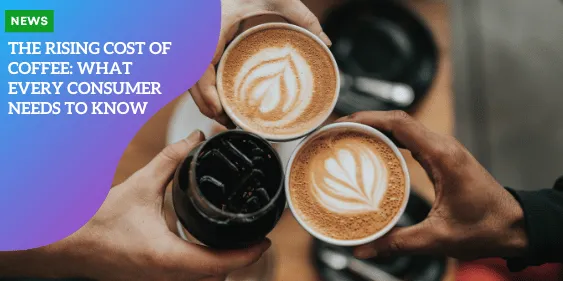The Rising Cost of Coffee: What Every Consumer Needs to Know

Increasing Global Demand for Coffee
Coffee, a beloved daily ritual for many, is experiencing a surge in global demand.
Whether it’s a morning pick-me-up or an afternoon social ritual, coffee’s importance in everyday life is undeniable.
This rising demand is driven by both developed and developing markets, where coffee consumption is becoming increasingly prevalent.
As more people elevate coffee from a mere beverage to a lifestyle necessity, the market is feeling the pressure.
Weather-Related Supply Disruptions in Brazil and Vietnam
While demand skyrockets, supply struggles to keep up. Brazil and Vietnam, which are crucial players in the coffee market, are facing significant weather-related challenges.
Brazil, which produces about 70% of the world’s arabica beans, and Vietnam, a major supplier of robusta beans, have seen their coffee crops impacted by adverse weather conditions like frosts and excessive rains.
These disruptions have caused shortages and driven up the cost of coffee beans significantly.
Impact on Both Robusta and Arabica Bean Markets
The effects of these supply constraints are felt across both the robusta and arabica markets.
Robusta beans, known for their strong and bitter flavor, are a staple in instant coffees and espresso blends, while arabica beans are prized for their smoother, more nuanced taste.
As supply from Brazil and Vietnam remains erratic, prices for both types of beans have surged.
This price increase doesn’t just affect the producers but cascades through the entire coffee supply chain, impacting roasters, cafes, and ultimately, consumers who may find their favorite cup of joe becoming a bit pricier.
With supply issues and rising demand creating a perfect storm, the coffee industry faces complex challenges that extend beyond just the cost of a cup of coffee.
This dynamic landscape requires a closer look at the broader supply chain to understand the full implications for everyone involved.
Supply Chain Challenges
Rising Container Shipping Rates
The shipping industry is facing significant challenges that directly impact the coffee supply chain.
Container shipping rates have skyrocketed, driven by a mix of ongoing pandemic-related disruptions and rising fuel costs.
Dr. Vinh Thai from RMIT highlights that this surge in shipping costs profoundly affects the overall coffee market.
As a result, the increase in transportation expenses is not just a logistical headache but a financial burden that trickles down through the supply chain.
Ongoing Supply Chain Issues
Beyond the increased shipping rates, the global coffee supply chain faces substantial hurdles that delay or complicate the transportation of coffee beans.
The pandemic has led to port congestions, reduced workforce availability, and regulatory changes that slow down the logistics process.
These issues often lead to prolonged shipping times and an overall reduction in shipping reliability.
This compounds the existing problem of weather-induced supply shortages in coffee-producing regions like Brazil and Vietnam, further inflating costs.
Cost Implications for Roasters and Cafes
These supply chain disruptions come at a considerable cost to coffee roasters and cafes.
The elevated shipping rates and logistical challenges force roasters to pay premium prices to secure coffee beans.
According to Dr. Thai, this cost pressure may necessitate roasters to pass on these expenses to cafes.
Consequently, cafes, already grappling with thin margins, may be forced to increase prices for consumers.
This is particularly critical in a market where consumers are also struggling with rising living expenses.
The compounded effect of these supply chain challenges stresses every link in the chain from bean producers to the end consumers.
Moving forward, solutions must focus on streamlining logistics and containing shipping costs to stabilize the coffee market and ease pressures on cafes and consumers.
Impact on Australian Coffee Industry
Pressure on the Workforce
The Australian coffee industry employs nearly 70,000 people, a figure that underscores its importance to the local economy.
However, this sector is currently under significant strain. Supply chain disruptions and rising shipping costs have imposed additional burdens on coffee businesses.
These challenges have led to increased operational costs, creating a tough environment for both employees and employers.
Many in the workforce are facing job insecurity as cafe owners grapple with maintaining their workforce amid mounting expenses.
Cafe Owners’ Profitability Struggle
Cafe owners are particularly feeling the pinch.
The costs associated with procuring coffee beans have surged, and many owners find themselves in a precarious position.
Abdullah Ramay, chief executive of Pablo & Rusty’s Coffee Roasters, highlighted this dilemma, noting that cafes are charging less than the “survivable” rate for coffee.
Operating a cafe has become a balancing act between fielding increasing costs and retaining customers who are also facing rising living expenses.
The fear is that if prices are not adjusted to reflect these new realities, many independent cafes may not be able to sustain their operations.
This sentiment was echoed by Sydney cafe owners, who find their vibrant coffee culture threatened by economic pressures.
They argue that despite the cultural significance of coffee in Australia, long-term sustainability requires customers to pay fair prices.
Coffee Prices in Sydney vs. Other Major Cities
Sydney, renowned for its coffee culture, currently enjoys lower coffee prices compared to most major global cities.
However, this pricing discrepancy is increasingly becoming a point of contention.
Industry experts argue that, to ensure sustainability, cafes may need to bring prices more in line with those in other parts of the world.
This anticipation of price hikes is concerning for consumers, but necessary for the survival of local coffee businesses.
Ending on this note, the chapter underscores the wider implications these economic dynamics have on both local businesses and culturally significant social practices related to coffee in Australia.
Consumer Implications
Potential Increase in Daily Coffee Costs
The cost of your daily coffee could get even higher in the upcoming months due to the increasing global demand for coffee and less availability.
Adverse weather in key growing regions like Brazil and Vietnam has wreaked havoc on the supply of both robusta and arabica beans, significantly driving prices up.
This is compounded by the rising container shipping rates and other supply chain issues, particularly as these costs trickle down from roasters to cafes, and ultimately, to customers.
Added Pressure on Consumers Amid Rising Living Expenses
With the rising expenses across all aspects of life, a hike in coffee prices adds another layer of financial strain on consumers.
As noted by RMIT professor of logistics and supply chain management, Dr. Vinh Thai, the continuing increase of container shipping rates and supply chain disruptions will likely exacerbate the cost of living pressures already felt by many.
Most consumers may find their daily coffee habit becoming less affordable, squeezing tighter budgets further.
Possible Changes in Coffee Consumption Habits
As costs rise, there might be significant changes in the way Australians consume coffee.
Some consumers may opt for cheaper alternatives, reduce their coffee intake, or switch to brewing coffee at home.
This transition, while economically sensible, could have larger implications for the vibrant cafe culture in cities like Sydney.
While some cafes may struggle to maintain profitability without raising prices to sustainable levels, the cultural importance of coffee as a social staple won’t easily diminish.
According to Associate Professor Bernardo Figueiredo from RMIT, younger demographics especially value the lifestyle aspect of coffee, suggesting that while consumption patterns might shift, overall demand for coffee will remain resilient.
Transitioning to the next chapter, we’ll take a closer look at how industry leaders and business owners are seeking solutions to ensure the long-term sustainability of cafes and the broader coffee market.
Industry Perspectives
Calls for Fair Pricing to Ensure Cafe Sustainability
The Australian coffee industry is facing a significant challenge: balancing the rising costs of coffee production with the need to maintain a fair price for consumers.
Experts argue that current prices may not be sustainable. Lachlan Ward, chief executive of St Ali coffee roasters, stated, “Unless Australian cafes start adjusting prices up and charging a fair price for what we are making, the independent cafe won’t exist in the future”.
Despite the rising costs passed down from roasters, many cafes are reluctant to increase their prices. According to Pablo & Rusty’s Coffee Roasters chief executive Abdullah Ramay, cafes are stuck “between a rock and a hard place” as they try to avoid becoming loss leaders.
He questioned why Sydney, a city known for its coffee culture, should have some of the cheapest coffee prices compared to other major cities worldwide.
Warnings About the Future of Independent Cafes
The grim reality is that without price adjustments, the future of independent cafes looks bleak.
The ongoing financial strain from global supply chain issues and higher shipping rates leaves independent cafes vulnerable.
If these establishments cannot adapt, we may see a decline in the number of small, owner-operated cafes, replaced by larger chains that can absorb costs more efficiently.
Dr. Vinh Thai of RMIT highlighted how rising container shipping rates and supply chain disruptions are significantly inflating costs throughout the coffee production process.
These increased expenses are likely to trickle down to consumers, potentially altering their coffee-drinking habits.
Debate on Sustainable Pricing in the Australian Market
As the conversation around coffee pricing heats up, industry leaders are calling for a shift towards sustainable pricing models.
There is a lively debate on how best to balance the needs of consumers, who are already burdened by rising living expenses, with the financial realities facing coffee producers and cafe owners.
RMIT Associate Professor Bernardo Figueiredo noted that while higher prices might push some consumers towards cheaper alternatives or home brewing, the cultural significance of coffee in Australia could keep overall demand stable.
“Given the cultural importance of coffee as a social and lifestyle symbol and its growth among the younger segments, it is unlikely that this would decrease the demand for coffee”.
Though opinions vary, one thing is clear: maintaining the vibrancy and quality of Australia’s coffee scene requires a delicate balance of fair pricing, consumer demand, and financial sustainability for cafes.
The journey to find this equilibrium is critical for the industry’s future, particularly as challenges in the global coffee market continue to unfold.
Consumer Responses and Future Outlook
Potential Shift to Cheaper Alternatives or Home Brewing
As coffee prices climb, consumers might look for more affordable options.
While cafes face higher operating costs, some coffee drinkers could switch to cheaper alternatives or opt for brewing their own coffee at home.
This can be a cost-effective solution, allowing people to maintain their caffeine fix without the strain on their wallets. Additionally, home brewing offers flexibility and customization, catering to personal taste preferences.
Cultural Importance of Coffee as a Social and Lifestyle Symbol
Despite the rising prices, the cultural significance of coffee can’t be ignored. Coffee is deeply ingrained in many cultures, especially in Australia, where it’s more than just a beverage.
It’s a social experience, an essential part of daily routines, and a lifestyle symbol.
Whether it’s the morning ritual of grabbing a cup from a favorite local café or gathering with friends over a cappuccino, coffee’s cultural importance helps sustain its demand even amid economic challenges.
Projected Demand Trends, Especially Among Younger Consumers
Interestingly, younger consumers continue to drive coffee demand.
The younger generation values experiences and sees coffee as part of their social identity.
They’re not just looking for a caffeine hit; they’re seeking out quality, sustainable, and ethically sourced coffee options.
This trend signifies that even if some consumers opt for cheaper alternatives, the overall demand for coffee remains stable, especially among younger demographics.
While rising coffee prices may shift consumer habits slightly, the enduring cultural and social importance of coffee ensures it remains a staple in daily life.







